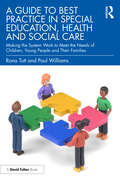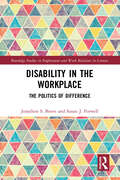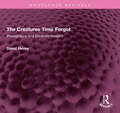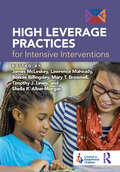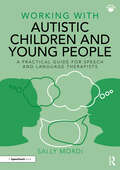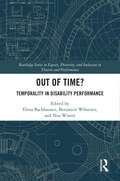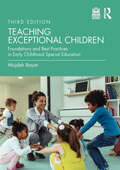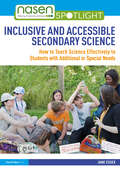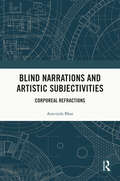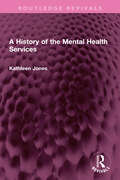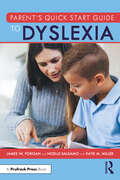- Table View
- List View
A Guide to Best Practice in Special Education, Health and Social Care: Making the System Work to Meet the Needs of Children, Young People and Their Families
by Rona Tutt Paul WilliamsA Guide to Best Practice in Special Education, Health and Social Care explores and explains the changes in governmental policies across the education, health and social care services, and what they mean for young individuals, parents and professionals. In a period of significant change, many practitioners need to understand the government’s plans for bringing about a more efficient, effective and sustainable system to meet the needs of young people and their families. Without trawling through reviews, green papers, white papers and bills, this book not only explains the significance of recent events, but provides practical examples, in the form of conversations and case studies, about how parents and professionals are making change happen. With decades of experience, Rona Tutt and Paul Williams delve deep into the separate origins of the three strands – the SEND Review, the review of children’s social care, and the Health and Care Act 2022. The book explores how pupils in different types of schools can have their needs met more effectively; how to make better use of available resources; and how to create a culture of mutual respect across all the three services.A Guide to Best Practice in Special Education, Health and Social Care not only fills in gaps in readers’ knowledge about the working of all three services, but provides innovative examples of how change is happening at ground level. People of all age groups working in schools and seeking to enhance their knowledge will find it to be an essential read. It will also be of interest to parents and professionals from across health and social care.
Disability in the Workplace: The Politics of Difference (Routledge Studies in Employment and Work Relations in Context)
by Jonathon S. Breen Susan J. ForwellThis book introduces the difference model of disability. Framed within an affect-based understanding of the relationships between those living with impairments and others, this new model offers a reconsideration of the construct of disability itself. Disability is flexible, relational, and perceived through an acognitive lens. At a practice level, the difference model offers a framework for creating more positive and successful relationships between people with disabilities (PWDs) and others within the workplace. This includes two new tools, the Co-Worker Acceptance of Disabled Employees (CADE) Scale and the Perceived Barriers to Employing Persons with Disabilities (PBED) Scale. Designed to measure workplace attitudes, and changes to these attitudes, each of these scales provides empirical evidence in support of strategic planning and, ultimately, an increased representation of PWDs. Finally, this book considers the effects of language and technology on workplace attitudes toward disability.
Disability in the Workplace: The Politics of Difference (Routledge Studies in Employment and Work Relations in Context)
by Jonathon S. Breen Susan J. ForwellThis book introduces the difference model of disability. Framed within an affect-based understanding of the relationships between those living with impairments and others, this new model offers a reconsideration of the construct of disability itself. Disability is flexible, relational, and perceived through an acognitive lens. At a practice level, the difference model offers a framework for creating more positive and successful relationships between people with disabilities (PWDs) and others within the workplace. This includes two new tools, the Co-Worker Acceptance of Disabled Employees (CADE) Scale and the Perceived Barriers to Employing Persons with Disabilities (PBED) Scale. Designed to measure workplace attitudes, and changes to these attitudes, each of these scales provides empirical evidence in support of strategic planning and, ultimately, an increased representation of PWDs. Finally, this book considers the effects of language and technology on workplace attitudes toward disability.
The Creatures Time Forgot: Photography and Disability Imagery (Routledge Revivals)
by David HeveyFirst published in 1992, The Creatures Time Forgot examines the representation of disabled people – in advertising, particularly that produced by disability charities, and in the work of photographers such as Diane Arbus and Gary Winogrand. He shows how such images construct disabled people as ‘creatures,’ the tragic-but-brave objects of photographic gaze, or as the ‘’appy ‘andicapped’ of ‘positive imagery’ advertising. As a disabled photographer and writer, David Hevey has been a pioneer in challenging such visual representations of disabled people. His work advocates a move away from medical, charity or impairment-fixated imagery towards a visual equivalent of ‘Rights not Charity’. The book outlines David Hevey’s own photographic practice and includes wide-ranging selections from his work to create a visual form which reflects the new social presence of disabled people. This book will be of interest to students of media studies, cultural studies, and disability studies.
The Creatures Time Forgot: Photography and Disability Imagery (Routledge Revivals)
by David HeveyFirst published in 1992, The Creatures Time Forgot examines the representation of disabled people – in advertising, particularly that produced by disability charities, and in the work of photographers such as Diane Arbus and Gary Winogrand. He shows how such images construct disabled people as ‘creatures,’ the tragic-but-brave objects of photographic gaze, or as the ‘’appy ‘andicapped’ of ‘positive imagery’ advertising. As a disabled photographer and writer, David Hevey has been a pioneer in challenging such visual representations of disabled people. His work advocates a move away from medical, charity or impairment-fixated imagery towards a visual equivalent of ‘Rights not Charity’. The book outlines David Hevey’s own photographic practice and includes wide-ranging selections from his work to create a visual form which reflects the new social presence of disabled people. This book will be of interest to students of media studies, cultural studies, and disability studies.
High Leverage Practices for Intensive Interventions
High Leverage Practices for Intensive Interventions provides special education teachers with descriptions and practical instructions on how to use High Leverage Practices (HLPs) to improve student outcomes. Since many students with disabilities spend their school day in inclusive general education classrooms, these intensive interventions are often delivered in separate or tier 3 settings to meet the students’ individualized needs. Each chapter focuses on a specific High Leverage Practice with explanations of its purpose and essential components, accompanied by examples for use with small groups of students or the individual student. This accessible and comprehensive guide is key for pre-service teachers in special education programs or those who provide intensive interventions with students.
High Leverage Practices for Intensive Interventions
by James McLeskey Lawrence Maheady Bonnie Billingsley Mary T. Brownell Timothy J. Lewis Alber-Morgan, Sheila R.High Leverage Practices for Intensive Interventions provides special education teachers with descriptions and practical instructions on how to use High Leverage Practices (HLPs) to improve student outcomes. Since many students with disabilities spend their school day in inclusive general education classrooms, these intensive interventions are often delivered in separate or tier 3 settings to meet the students’ individualized needs. Each chapter focuses on a specific High Leverage Practice with explanations of its purpose and essential components, accompanied by examples for use with small groups of students or the individual student. This accessible and comprehensive guide is key for pre-service teachers in special education programs or those who provide intensive interventions with students.
The Educator’s Guide to ADHD Interventions: Strategies for Grades 5-12
by Judith R. Harrison Denise A. Soares Steven W. EvansDesigned specifically for middle and high school educators, this guidebook clearly and thoroughly breaks down effective classroom-based interventions for students with ADHD. Chapters walk readers through each intervention, providing step-by-step implementation guides, describing potential pitfalls and offering critical tips and advice to help you ensure that your interventions are both culturally responsive and sustainable. Filled with helpful templates and tools, this book is essential reading for anyone who needs help creating effective, sustainable interventions for students with ADHD.
The Educator’s Guide to ADHD Interventions: Strategies for Grades 5-12
by Judith R. Harrison Denise A. Soares Steven W. EvansDesigned specifically for middle and high school educators, this guidebook clearly and thoroughly breaks down effective classroom-based interventions for students with ADHD. Chapters walk readers through each intervention, providing step-by-step implementation guides, describing potential pitfalls and offering critical tips and advice to help you ensure that your interventions are both culturally responsive and sustainable. Filled with helpful templates and tools, this book is essential reading for anyone who needs help creating effective, sustainable interventions for students with ADHD.
Working with Autistic Children and Young People: A Practical Guide for Speech and Language Therapists (Working With)
by Sally MordiThis book focuses on appreciating the different language and communication style of autistic youngsters and discusses how therapists can respond to and support this to get the best out of their practice. Each chapter begins with a summary of key points and areas to focus on, includes ‘what to do’ ideas and mini case-studies to illustrate points, as well as signposting further reading. The book draws on relevant theory and offers practical insights to allow the therapist to develop confidence, knowledge and skills. Topics covered include: identifying effective support, emotional regulation, working with technology, specific groups such as girls with autism. Linking theory and practice in an engaging and easy-to-follow format, The book provides practical ideas that are immediately helpful for busy professionals to guide clinical decision making and intervention. It is an invaluable addition to the tool kit of any speech and language therapist, as well as other professionals wanting an overview of how to work with autistic children and young people in our neurodiverse society.
Working with Autistic Children and Young People: A Practical Guide for Speech and Language Therapists (Working With)
by Sally MordiThis book focuses on appreciating the different language and communication style of autistic youngsters and discusses how therapists can respond to and support this to get the best out of their practice. Each chapter begins with a summary of key points and areas to focus on, includes ‘what to do’ ideas and mini case-studies to illustrate points, as well as signposting further reading. The book draws on relevant theory and offers practical insights to allow the therapist to develop confidence, knowledge and skills. Topics covered include: identifying effective support, emotional regulation, working with technology, specific groups such as girls with autism. Linking theory and practice in an engaging and easy-to-follow format, The book provides practical ideas that are immediately helpful for busy professionals to guide clinical decision making and intervention. It is an invaluable addition to the tool kit of any speech and language therapist, as well as other professionals wanting an overview of how to work with autistic children and young people in our neurodiverse society.
Out of Time?: Temporality In Disability Performance (Routledge Series in Equity, Diversity, and Inclusion in Theatre and Performance)
by Elena Backhausen Benjamin Wihstutz Noa WinterOut of Time? has many different meanings, amongst them outmoded, out of step, under time pressure, no time left, or simply delayed. In the disability context, it may also refer to resistant attitudes of living in “crip time” that contradict time as a linear process with a more or less predictable future. According to Alison Kafer, “crip time bends the clock to meet disabled bodies and minds.” What does this mean in the disability arts? What new concepts of accessibility, crip futures, and crip resistance can be staged or created by disability performance? And how does the notion of “out of time” connect crip time with pandemic time in disability performance? The collective volume seeks to respond to these questions by exploring crip time in disability performance as both a concept and a phenomenon. The book tackles the topic from two angles: on the one hand from a theoretical point of view that connects performance analysis with crip and performance theory, on the other hand from a practice-based perspective of disability artists who develop new concepts and dramaturgies of crip time based on their own lived experiences and observations in the field of the performing and disability arts. The book gathers different types of text genres, forms, and styles that mirror the diversity of their authors. Besides theoretical and academic chapters on disability performance, the book also includes essays, poems, dramatic texts, and choreographic concepts that ref lect upon the alternative knowledge in the disability arts.
Out of Time?: Temporality In Disability Performance (Routledge Series in Equity, Diversity, and Inclusion in Theatre and Performance)
by Elena BackhausenOut of Time? has many different meanings, amongst them outmoded, out of step, under time pressure, no time left, or simply delayed. In the disability context, it may also refer to resistant attitudes of living in “crip time” that contradict time as a linear process with a more or less predictable future. According to Alison Kafer, “crip time bends the clock to meet disabled bodies and minds.” What does this mean in the disability arts? What new concepts of accessibility, crip futures, and crip resistance can be staged or created by disability performance? And how does the notion of “out of time” connect crip time with pandemic time in disability performance? The collective volume seeks to respond to these questions by exploring crip time in disability performance as both a concept and a phenomenon. The book tackles the topic from two angles: on the one hand from a theoretical point of view that connects performance analysis with crip and performance theory, on the other hand from a practice-based perspective of disability artists who develop new concepts and dramaturgies of crip time based on their own lived experiences and observations in the field of the performing and disability arts. The book gathers different types of text genres, forms, and styles that mirror the diversity of their authors. Besides theoretical and academic chapters on disability performance, the book also includes essays, poems, dramatic texts, and choreographic concepts that ref lect upon the alternative knowledge in the disability arts.
Teaching Exceptional Children: Foundations and Best Practices in Early Childhood Special Education
by Mojdeh BayatTeaching Exceptional Children is the ideal textbook for introductory graduate and undergraduate courses on early childhood special education and teaching in inclusive classrooms. Bayat’s clear and accessible writing, the text’s visually appealing design, and the focused pedagogy included in each chapter help make it possible for students and instructors to cover a significant amount of material. This powerful text identifies specific behavioral characteristics and presents theoretical information grounded in neuroscience and child development research for a wide range of disabilities. Chapters provide research-based best practices for effectively working with children with various disabilities in inclusive classrooms. This third edition has been fully updated with recent research and includes new sections on Universal Design for Learning, adaptations, technology, and common challenges in inclusive early childhood classrooms. This book is also accompanied by a robust collection of online resources for instructors and students, providing full support, including a Companion Website featuring an Instructor's Manual with additional ideas for assignments and projects, web and video links with reflection questions, a test bank, and lecture slides; and an eBook+ offering interactive links to videos, glossary terms, and more!
Teaching Exceptional Children: Foundations and Best Practices in Early Childhood Special Education
by Mojdeh BayatTeaching Exceptional Children is the ideal textbook for introductory graduate and undergraduate courses on early childhood special education and teaching in inclusive classrooms. Bayat’s clear and accessible writing, the text’s visually appealing design, and the focused pedagogy included in each chapter help make it possible for students and instructors to cover a significant amount of material. This powerful text identifies specific behavioral characteristics and presents theoretical information grounded in neuroscience and child development research for a wide range of disabilities. Chapters provide research-based best practices for effectively working with children with various disabilities in inclusive classrooms. This third edition has been fully updated with recent research and includes new sections on Universal Design for Learning, adaptations, technology, and common challenges in inclusive early childhood classrooms. This book is also accompanied by a robust collection of online resources for instructors and students, providing full support, including a Companion Website featuring an Instructor's Manual with additional ideas for assignments and projects, web and video links with reflection questions, a test bank, and lecture slides; and an eBook+ offering interactive links to videos, glossary terms, and more!
Inclusive and Accessible Secondary Science: How to Teach Science Effectively to Students with Additional or Special Needs (nasen spotlight)
by Jane EssexDrawing on extensive professional experience and detailed empirical evidence, this resource sets out an insightful, highly practical approach to teaching science to secondary-aged students with learning difficulties and other special educational or additional support needs (SEND/ASN). The book explores the barriers that the secondary school science curriculum currently presents to those who do not learn in the expected way, before providing a wealth of practical strategies to help teachers, in both specialist and mainstream settings, to make science more accessible. Multiple science topics are covered in depth, including living and non-living matter, the periodic table, electrical energy, the solar system, the environment and more. Each topic is supported by extensive teachers’ notes outlining activities that will allow educational practitioners to enact the principles of accessibility in the classroom. With rich field notes and practical takeaways included to accompany key insights, this accessible book will provide science teachers at the secondary school level, as well as support staff and anyone aspiring to teach science to SEN/ASN learners, with the guidance and resources they need to make science education meaningfully inclusive.
Inclusive and Accessible Secondary Science: How to Teach Science Effectively to Students with Additional or Special Needs (nasen spotlight)
by Jane EssexDrawing on extensive professional experience and detailed empirical evidence, this resource sets out an insightful, highly practical approach to teaching science to secondary-aged students with learning difficulties and other special educational or additional support needs (SEND/ASN). The book explores the barriers that the secondary school science curriculum currently presents to those who do not learn in the expected way, before providing a wealth of practical strategies to help teachers, in both specialist and mainstream settings, to make science more accessible. Multiple science topics are covered in depth, including living and non-living matter, the periodic table, electrical energy, the solar system, the environment and more. Each topic is supported by extensive teachers’ notes outlining activities that will allow educational practitioners to enact the principles of accessibility in the classroom. With rich field notes and practical takeaways included to accompany key insights, this accessible book will provide science teachers at the secondary school level, as well as support staff and anyone aspiring to teach science to SEN/ASN learners, with the guidance and resources they need to make science education meaningfully inclusive.
Blind Narrations and Artistic Subjectivities: Corporeal Refractions
by Aravinda BhatBlind Narrations and Artistic Subjectivities: Corporeal Refractions makes an important contribution to the field of blindness studies by highlighting the centrality of blindness in literary compositions. It presents a critical interpretation of selected prose writings by three blind authors: Argentine poet and essayist Jorge Luis Borges; Australian religious educator and diarist John M. Hull; and the American memoirist and poet Stephen Kuusisto. The volume discusses themes like theorizing the corporeality of writing aesthetic turn to the experience of blindness altered sensation and self-understanding lived experience of growing blind self-knowledge through interaction with the world artistic subjectivity, narrative choices, and the implied author This book will be useful for scholars and researchers of blindness studies, disability studies, arts and aesthetics, literature, cultural studies, and philosophy.
Blind Narrations and Artistic Subjectivities: Corporeal Refractions
by Aravinda BhatBlind Narrations and Artistic Subjectivities: Corporeal Refractions makes an important contribution to the field of blindness studies by highlighting the centrality of blindness in literary compositions. It presents a critical interpretation of selected prose writings by three blind authors: Argentine poet and essayist Jorge Luis Borges; Australian religious educator and diarist John M. Hull; and the American memoirist and poet Stephen Kuusisto. The volume discusses themes like theorizing the corporeality of writing aesthetic turn to the experience of blindness altered sensation and self-understanding lived experience of growing blind self-knowledge through interaction with the world artistic subjectivity, narrative choices, and the implied author This book will be useful for scholars and researchers of blindness studies, disability studies, arts and aesthetics, literature, cultural studies, and philosophy.
Beating Bureaucracy in Special Educational Needs: Helping SENCOs Maintain a Work/Life Balance (nasen spotlight)
by Jean GrossAre you overwhelmed by the amount of paperwork that SEND generates in your school? Would you like to spend more time improving the quality of teaching and learning for pupils with SEN or disabilities? If so, this is an essential book for you. Beating Bureaucracy in Special Educational Needs shows how schools can tackle SEND bureaucracy by reducing the need for provision that is ‘additional to or different from’ that available to all pupils, through developing inclusive environments, curricula and teaching. This means placing fewer children on SEND registers and focusing SEND Code of Practice procedures squarely on those pupils with more complex needs. Fully revised and updated, the fourth edition of this bestselling, practical text demonstrates what can be achieved, with new case studies describing schools with outstanding SEND provision, inclusive teaching and successful partnerships with parents. The book also explores how SENCOs can effectively reduce their workloads by making the most of technology and by distributing responsibility to class and subject teachers and middle and senior leaders, rather than operating as a lone voice. A toolkit of ready-to-use proformas, also available as an online resource, includes: a model policy to give to Ofsted; information for parents, including the facts on ‘Velcro’ 1–1 support in the classroom; strategy sheets for all the main types of SEND; provision maps and proformas to help you plan, monitor and evaluate your provision. Full of helpful and achievable strategies, this book is an essential resource for school leaders, SENCOs and anyone undertaking national SENCO qualifications. It shows how to put responsibility for supporting children with additional needs firmly back where it belongs and will help you – in the words of one SENCO – ‘get your life back’.
Beating Bureaucracy in Special Educational Needs: Helping SENCOs Maintain a Work/Life Balance (nasen spotlight)
by Jean GrossAre you overwhelmed by the amount of paperwork that SEND generates in your school? Would you like to spend more time improving the quality of teaching and learning for pupils with SEN or disabilities? If so, this is an essential book for you. Beating Bureaucracy in Special Educational Needs shows how schools can tackle SEND bureaucracy by reducing the need for provision that is ‘additional to or different from’ that available to all pupils, through developing inclusive environments, curricula and teaching. This means placing fewer children on SEND registers and focusing SEND Code of Practice procedures squarely on those pupils with more complex needs. Fully revised and updated, the fourth edition of this bestselling, practical text demonstrates what can be achieved, with new case studies describing schools with outstanding SEND provision, inclusive teaching and successful partnerships with parents. The book also explores how SENCOs can effectively reduce their workloads by making the most of technology and by distributing responsibility to class and subject teachers and middle and senior leaders, rather than operating as a lone voice. A toolkit of ready-to-use proformas, also available as an online resource, includes: a model policy to give to Ofsted; information for parents, including the facts on ‘Velcro’ 1–1 support in the classroom; strategy sheets for all the main types of SEND; provision maps and proformas to help you plan, monitor and evaluate your provision. Full of helpful and achievable strategies, this book is an essential resource for school leaders, SENCOs and anyone undertaking national SENCO qualifications. It shows how to put responsibility for supporting children with additional needs firmly back where it belongs and will help you – in the words of one SENCO – ‘get your life back’.
A History of the Mental Health Services (Routledge Revivals)
by Kathleen JonesFirst published in 1972, A History of the Mental Health Services is a revised and abridged version of both Lunacy, Law and Conscience and Mental Health and Social Policy, rewriting the material from the end of the Second World War to the passing of the Mental Health Act 1959, and adding a new section which runs from 1959 to the Social Services Act 1970. The story starts with the first legislative mention of the ‘furiously and dangerously mad’ as a class for whom some treatment should be provided, traces the development of reform and experiment in the nineteenth century, and the creation of the asylum system, and ends in the age of Goffman and Laing and Szasz with the virtual disappearance of the system. The book will be of interest to students of mental health, sociology, social policy, health policy and law.
A History of the Mental Health Services (Routledge Revivals)
by Kathleen JonesFirst published in 1972, A History of the Mental Health Services is a revised and abridged version of both Lunacy, Law and Conscience and Mental Health and Social Policy, rewriting the material from the end of the Second World War to the passing of the Mental Health Act 1959, and adding a new section which runs from 1959 to the Social Services Act 1970. The story starts with the first legislative mention of the ‘furiously and dangerously mad’ as a class for whom some treatment should be provided, traces the development of reform and experiment in the nineteenth century, and the creation of the asylum system, and ends in the age of Goffman and Laing and Szasz with the virtual disappearance of the system. The book will be of interest to students of mental health, sociology, social policy, health policy and law.
Parent’s Quick Start Guide to Dyslexia
by James W. Forgan Noelle BalsamoParent’s Quick Start Guide to Dyslexia provides parents and caregivers with an immediate overview of dyslexia and steps they can take to support and encourage their child. Each chapter is packed with detailed and helpful information, covering identification, public schools versus private settings, and how (and when) to seek professional help. Summary and resource sections at the end of each chapter give quick guidance to busy readers. Topics include a wealth of research-backed activities, nurturing talent and creativity, motivating your child to read, and more. Offering straightforward, easy to understand, and evidence-based information, this book is a go-to resource for caregivers parenting a child with dyslexia.
Parent’s Quick Start Guide to Dyslexia
by James W. Forgan Noelle BalsamoParent’s Quick Start Guide to Dyslexia provides parents and caregivers with an immediate overview of dyslexia and steps they can take to support and encourage their child. Each chapter is packed with detailed and helpful information, covering identification, public schools versus private settings, and how (and when) to seek professional help. Summary and resource sections at the end of each chapter give quick guidance to busy readers. Topics include a wealth of research-backed activities, nurturing talent and creativity, motivating your child to read, and more. Offering straightforward, easy to understand, and evidence-based information, this book is a go-to resource for caregivers parenting a child with dyslexia.
